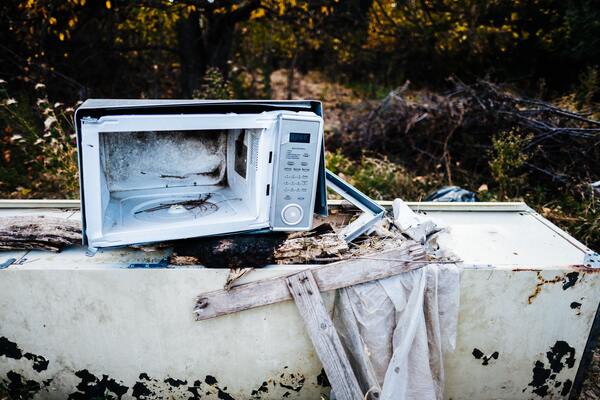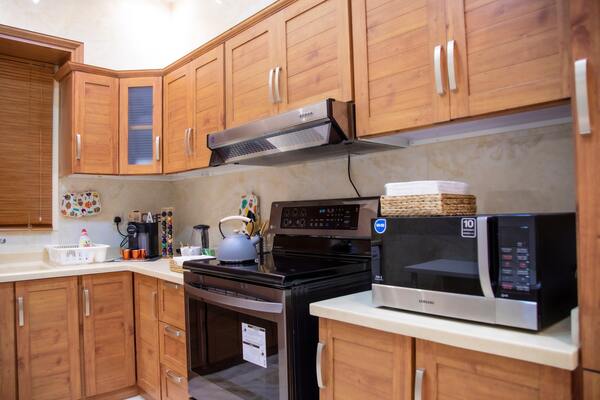What causes your microwave to frequently trip the circuit breaker? Currently, the electrical circuit is overloaded by the microwave. In other words, the circuit can only handle a certain number of amps (a unit of electrical current), and the microwave is using more than that, tripping the breaker. Here are 9 reasons with related solutions that may cause your microwave tripping the breaker.
Your Circuit Breaker Is Overloaded
The circuit breaker is overloaded, which is the simplest explanation for why your microwave is tripping it. This could occur for a number of reasons, including a broken microwave or too many electrical devices plugged into one circuit. The latter is more frequently the case.
Solution: the best solution for the overloaded circuit is to get a dedicated electrical circuit for your microwave oven.
Your Microwave Is Faulty
You might be dealing with a defective microwave if the microwave is indeed on a dedicated circuit. You can test in a variety of ways to see if this is the case.
Solution: First, you should plug your microwave into a higher amp circuit, like a garage outlet or a circuit that you are sure is set aside.
There is a good chance that the microwave itself is broken if this breaker trips. If the circuit breaker is not tripped, all you really need is a microwave-specific circuit.
Your Door Safety Latch Is Malfunctioning
The safety latch mechanism consists of a number of switches. The microwave won’t work properly if any of the latch hooks on the door are damaged or if the switches are malfunctioning. A blown fuse or circuit trip could happen as a result of this.
Solution: you need to identify if the door latch switches are faulty or sometimes not installed correctly.
High voltage current poses a risk if you check things yourself and have the necessary tools and knowledge. We advise contacting an appliance repairman.

The Turntable Motor Has Moisture In It
The part of the microwave that enables the microwave to evenly and consistently cook your food is the turntable motor. There is always a chance that something could spill while cooking your food underneath the turntable.
If you don’t clean it up right away, moisture may seep into the turntable motor and cause electrical problems that trip the circuit breaker.
Solution: To discharge the capacitor and unplug the microwave, first. The turntable motor can be found underneath the microwave, so find that next. Verify that all connectors are unplugged.
The Capacitor Is Defective
The capacitor’s purpose is to store energy until it can release it in an amplified form. If this part is broken, the microwave will operate with a loud noise. When that happens, a fuse may blow or a circuit breaker may trip.
Solution: Disconnect the appliance from the power source and discharge the capacitor using an electrically insulated tool to test the capacitor and see if this component is the problem. You run a significant risk of electrocution if you don’t do this.
After disconnecting all connectors from the capacitor, attach the probe ends of the multimeter tool to the capacitor’s terminals.
A Problem With The Electrical Supply
A problem with the overall electrical supply may also be the cause of the circuit breaker tripping when your microwave is on.
Solution: once the problem is identified, you can replace yourself or contact the electrical appliances, or maintenance person.
The Timer Is Jammed
Either a mechanical or electronic timer will be included in your microwave. The circuit may trip or a fuse may blow if one or more of the timer’s electrical contacts are compromised.
Solution: You can examine this component’s condition, but make sure you strictly follow the safety precautions while doing so.
The High Voltage Diode Is Short-circuiting
Stacking eight diodes together creates the high voltage diode. The HV diode cannot be tested with a multimeter as a result of this stacking. It has two ends: one that attaches to the capacitor and the other to the ground of your microwave.
Solution: Your appliance may make a loud noise and possibly blow a fuse or trip the circuit if the HV diode is short-circuiting or leaking electricity.
The Capacitor Is Faulty
The capacitor stores energy, which it then amplifies before releasing. The appliance will make a loud noise when operating if it is defective, and it may even blow its fuse or trip your electricity.
Until the capacitor has been discharged by being short-circuited with an electrically insulated tool and removed from the power source, you should not test it. You could be electrocuted if you do not.
Solution: Place your multimeter’s probe tips on each of the capacitor’s terminals in ohmmeter mode after disconnecting the connectors from the capacitor. if you don’t obtain a value, the capacitor is defective.
The capacitor’s potential for an electrical leak can also be tested. To do this, place one of the multimeter’s probes on a capacitor’s terminal and the other probe on the appliance’s metal frame or casing.
Apply the same procedure to all of the capacitor’s terminals. No values should be acquired. If you do, you’ll have to swap out this component.
The Magnetron Has An Electrical Leak
The microwave’s outer shell contains the magnetron. It emits electromagnetic waves and is powered by the electrical current delivered to the appliance. It will trip the circuit breaker if there is an electrical leak.
Solution: Disconnect the connectors from the magnetron and set the probes of the multimeter on its terminals to take the measurement. The magnetron is operating properly and is not the cause of the issue if the value you obtain is close to zero.
Additionally, look for any current leaks to further confirm the outcome.
Put one probe’s tip on the magnetron’s metal outer casing and the other probe’s tip on one of its connection terminals to accomplish this. Each terminal needs to have the procedure repeated.
Make Sure The Microwave Has A Dedicated Circuit
A dedicated 20-amp circuit is required for the microwave, which draws about 12 amps. Therefore, they shouldn’t be using the same circuit as any other appliances.
The circuit will quickly become overloaded and trip the breaker if the microwave is currently connected to a circuit that also houses other devices and operates at the same time as those devices.
How can you tell whether your microwave is on a dedicated circuit or not?
Verify the label on the tripped breaker. Is the word “microwave” there? If not, your microwave most likely lacks a dedicated circuit.
Whether or not the microwave is on a separate circuit, there may be a problem with the microwave that is causing it to draw too much power and trip the breaker.
Conclusion
Kitchen appliances like the microwave are essential. Machines that are subjected to rough handling produce errors as well as some negative effects, such as tripping breakers and blowing fuses. You require a dedicated circuit to prevent circuit tripping and breaking.
